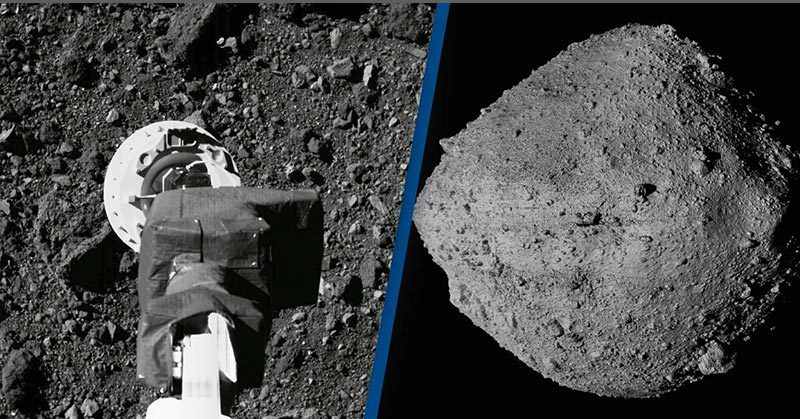On Tuesday, October 20, 2020, NASA made history when they touched an asteroid with a special spacecraft for the very first time. The information from the sample they collected could give us valuable information about our solar system and how Earth was formed. (1)
NASA Touches Asteroid Bennu
A NASA special spacecraft was able to collect some dust and pebbles from asteroid Bennu, an over 4.5 billion-year-old asteroid that was formed within the first 10 million years of our solar system’s history. (1, 2)
Most likely originating in the main asteroid belt between Mars and Jupiter, Bennu is currently over 200 million miles (321 million kilometers) away from Earth. It was formed billions of years ago and has been throwing around ingredients that may have helped start life on Earth ever since. (1, 2)
“This amazing first for NASA demonstrates how an incredible team from across the country came together and persevered through incredible challenges to expand the boundaries of knowledge,” said NASA Administrator Jim Bridenstine. “Our industry, academic, and international partners have made it possible to hold a piece of the most ancient solar system in our hands.” (1)
If the sample collection, known as a Touch-and-Go (TAG) event, provided an adequate amount of sample, then the spacecraft will begin its return to Earth, arriving by 2023. If not, they will make another attempt in January. (1)
Read: A Mysterious Crater Suddenly Opened Up in the Arctic Tundra
The TAG Asteroid Event
Launched four years ago, the spacecraft OSIRIS-REx was finally within orbit of asteroid Bennu. It folded out its mechanical arm and began making its way closer to Bennu’s surface. After a four hour descent, it then had to find a safe place to land. (1)
It made its way past a boulder nick-named “Mount Doom” and continued until it found a clear spot in a crater in Bennu’s northern hemisphere. The mission was successful. (1)
“After over a decade of planning, the team is overjoyed at the success of today’s sampling attempt,” said Dante Lauretta, OSIRIS-REx principal investigator at the University of Arizona in Tucson. “Even though we have some work ahead of us to determine the outcome of the event – the successful contact, the TAGSAM gas firing, and back-away from Bennu are major accomplishments for the team. I look forward to analyzing the data to determine the mass of sample collected.” (1)
The team will take approximately one week to determine how many samples they have collected. They hope that OSIRIS-REx collected at least 60 grams of material, which is about the size of a candy bar. (1)
Read: Photographer ‘Accidentally’ Captures Incredible Photos of a Brilliant Green Meteor
Fun Facts About Asteroid Bennu
Besides being extremely old and possibly partially responsible for helping to form the planet that we call home, Bennu is interesting for a number of reasons.
- Bennu is dark in color, as it contains a high amount of carbon. This makes it a b-type classified asteroid. (2)
- It hasn’t experienced much composition change. This means that on, and under, it’s pitch-black surface are rocks and chemicals from the birth of our solar system. (2)
- Bennu is about 60 miles (100 km) wide and is about as tall as the Empire State building. (2)
- The asteroid is full of holes, making 20 to 40 percent of its volume empty space. (2)
- Bennu could be a source of water, platinum, and gold. The water is most important, as it could help make deeper space exploration for astronauts feasible. (2)
- A nine-year-old boy named Bennu after winning NASA’s Name that Asteroid! contest. He named it after an ancient Egyptian Deity linked with the sun, creation, and rebirth. (2)
- Bennu is a rare active asteroid, spewing out streams of particles more than once a week. (2)
One Step Further for NASA
While there is still plenty to do from here, OSIRIS-REx’s landing on Bennu is an exciting step forward for NASA. The materials collected may provide us with clues as to how the Earth and much of the rest of our solar system was formed and may allow us to travel further into the galaxy than ever before. (1)
Keep Reading: Man Keeps Rock For Years, Hoping It’s Gold. It Turned Out to Be Far More Valuable

